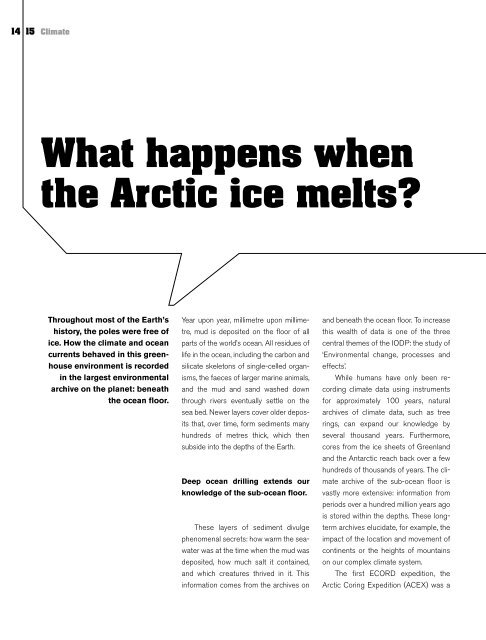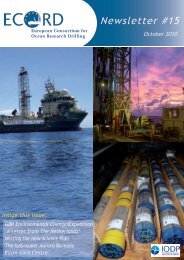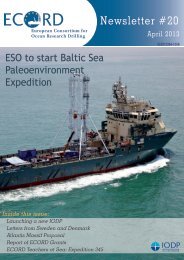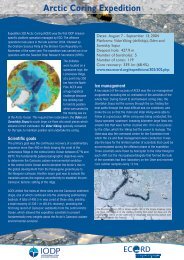printable version - European Consortium for Ocean Research Drilling
printable version - European Consortium for Ocean Research Drilling
printable version - European Consortium for Ocean Research Drilling
- No tags were found...
Create successful ePaper yourself
Turn your PDF publications into a flip-book with our unique Google optimized e-Paper software.
14 15 ClimateWhat happens whenthe Arctic ice melts?Throughout most of the Earth’shistory, the poles were free ofice. How the climate and oceancurrents behaved in this greenhouseenvironment is recordedin the largest environmentalarchive on the planet: beneaththe ocean floor.Year upon year, millimetre upon millimetre,mud is deposited on the floor of allparts of the world’s ocean. All residues oflife in the ocean, including the carbon andsilicate skeletons of single-celled organisms,the faeces of larger marine animals,and the mud and sand washed downthrough rivers eventually settle on thesea bed. Newer layers cover older depositsthat, over time, <strong>for</strong>m sediments manyhundreds of metres thick, which thensubside into the depths of the Earth.Deep ocean drilling extends ourknowledge of the sub-ocean floor.These layers of sediment divulgephenomenal secrets: how warm the seawaterwas at the time when the mud wasdeposited, how much salt it contained,and which creatures thrived in it. Thisin<strong>for</strong>mation comes from the archives onand beneath the ocean floor. To increasethis wealth of data is one of the threecentral themes of the IODP: the study of‘Environmental change, processes andeffects’.While humans have only been recordingclimate data using instruments<strong>for</strong> approximately 100 years, naturalarchives of climate data, such as treerings, can expand our knowledge byseveral thousand years. Furthermore,cores from the ice sheets of Greenlandand the Antarctic reach back over a fewhundreds of thousands of years. The climatearchive of the sub-ocean floor isvastly more extensive: in<strong>for</strong>mation fromperiods over a hundred million years agois stored within the depths. These longtermarchives elucidate, <strong>for</strong> example, theimpact of the location and movement ofcontinents or the heights of mountainson our complex climate system.The first ECORD expedition, theArctic Coring Expedition (ACEX) was aparticular success in advancing our understandingof past climate change. Upuntil this point, little was known aboutthe history of the Arctic <strong>Ocean</strong>. Due tothe difficulties posed by the moving ice,deep drilling in the Arctic waters wasconsidered impossible.The Arctic is a key region <strong>for</strong> theworld’s climate.However, ECORD researchers andtechnologists, led by Jan Backman ofthe University of Stockholm, Sweden,and Kate Moran from the University ofRhode Island, USA, pulled off a sensationalfeat: they retrieved cores of up to430 m in length from the central Arctic<strong>Ocean</strong>, only 250 km from the North Poleitself. The samples revealed the historyof the Arctic climate over the last 56 millionyears, a time during which the worldchanged from humid, greenhouse conditionsto those of an icehouse. The expeditionbrought incredible facts to light:55 million years ago, a good ten millionyears after the extinction of the dinosaurs,the Arctic seas were as warm asthe present Mediterranean Sea in July– around 24 degrees centigrade. “That’sten degrees more than climate modelsreported”, said expedition co-chief, scientistJan Backman. It is puzzling howwarmth was transported so far north.The gradual cooling to our present interglacialclimate is documented within thearctic sediments in similar detail.A model <strong>for</strong> current global warmingThe period of warmth 55 millionyears ago is of particular interest to climatologists:it provides a model <strong>for</strong> thecurrent episode of global warming. Atthat time, the carbon dioxide levels inthe atmosphere rose at similar rates tothe present day and global temperaturesrose by four to five degrees centigrade.One possible cause of this heat wave,which lasted several thousand years,was oceanic landslides. These submarineslides uncovered vast deposits ofmethane-hydrate ice, releasing largequantities of methane into the atmosphere.There is a difference however:due to the fact that the Earth at that timewas already free of ice, temperaturesrose equally around the globe. The situationlooks very different today: climatologistspredict particularly drastic warmingin polar regions in the future.







